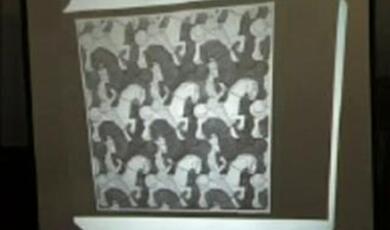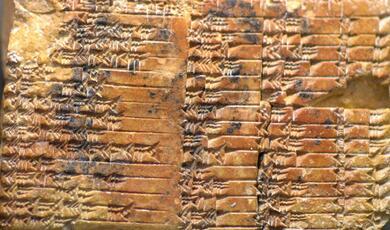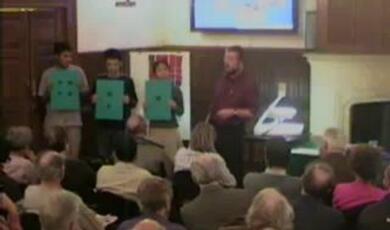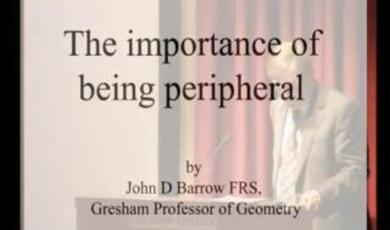Wallpaper Patterns and Buckyballs
Share
- Details
- Transcript
- Audio
- Downloads
- Extra Reading
We are all familiar with patterned wallpaper, but how many regular patterns are there? Can you tile your bathroom floor with square, hexagonal and octagonal tiles? Footballs are made up of pentagons and hexagons, but how many pentagons are there? What are buckyballs, and what have they to do with the Montreal World Fair?
Download Transcript
WALLPAPER PATTERNS AND BUCKYBALLS
Professor Robin Wilson
My lectures this term will be in the area of combinatorics – the subject of counting, arranging and sorting mathematical objects. Next month I’ll tell you about trees and graph theory and about the theory of designs, but today we’re doing something more geometrical – and there’ll be lots of pretty pictures to look at.
Although my title is Wallpaper patterns and buckyballs, I won’t actually say very much about either of these – rather, I’ll use them as vehicles for introducing the subjects of tilings (often called tessellations) andpolyhedra. By the time you leave here today, you’ll have lots of ideas for tiling your bathroom floor and for making some attractive decorations to hang on the tree next Christmas.
Tilings
How can we define a tiling of the plane? We probably want the tiles to form a regular pattern – one that can be extended as far as we wish. But then we need to make some decisions. Do we want to allow our tiles to have curved sides, or must all the sides be straight – as in a square or a hexagon? If so, should the polygons all be regular, and should they all be the same? Must the pattern repeat periodically however far out we go?
For the purpose of making progress, we’ll require that each tile is a convex polygon, but we won’t always require them all to be the same.
We’ll also make an extra condition – that the tiles are in edge-to-edge contact, so that each edge of one tile coincides exactly with the edge of the adjoining tile: we call this an edge-to-edge tiling.
From now on we’ll usually tile the plane with regular polygons, where all the sides and all the angles are the same – an equilateraltriangle, asquare, and a regular pentagon, hexagon, heptagon, octagon anddodecagon (with twelve sides). Since we want to fit them together without gaps, we’ll need to know their internal angles – for the triangle this is 60°, the square 90°, the pentagon 108°, the hexagon 120°, the heptagon just over 129°, the octagon 135°, and the dodecagon 150°.
Suppose now that we want to find all the regular tilings – those in which all the tiles are regular polygons of the same type, and the arrangement of polygons at all the vertices is the same. It’s clear that the internal angle must then divide exactly into 360° – the only possibilities are the triangle (60°), the square (90°) and the hexagon (120°). All of these work, giving us:
the triangular tiling with six triangles around each vertex (which we notate by the ‘vertex code’ 3.3.3.3.3.3); the square tiling with four squares around each vertex (4.4.4.4); the hexagonal tiling or honeycomb with three hexagons around each vertex (6.6.6).
Next we’ll relax the condition that all the polygons must be of the same type, but we’ll still require that we get the same arrangement of polygons around each vertex. We now need to find all the combinations of internal angles (not all the same) which make up 360°. There are eighteen of these, ranging from 3.3.3.3.6 (four triangles and a hexagon) and 3.12.12 (a triangle and two dodecagons) to 3.7.42 (a triangle, a heptagon and a 42-gon). However, only eight of these can be extended to the whole plane, giving us the semi-regular tilings with the following vertex codes:
3.3.4.3.4; 3.12.12; 3.4.6.4; 4.8.8; 3.3.3.3.6; 3.3.3.4.4; 4.6.12; 3.6.3.6.
(Here the polygons are listed in clockwise order as we go around each vertex, so that 3.3.4.3.4 and 3.3.3.4.4, which both have three triangles and two squares, give rise to different tilings; note also that the fifth of these tilings can exist in both ‘left-hand’ and ‘right-hand’ versions.)
We can generalise further and drop the condition that the arrangement of polygons around all the vertices are the same – there may be two or more vertex codes. This leads to an infinite variety of patterns, which are known as demi-regular tilings.
A few years ago, Roger Penrose (Gresham Professor of Geometry from 1998-2001) produced some interesting examples of infinite tilings, now called Penrosetilings, that are not periodic – they are built from two or more shapes (such as a ‘kite’ and a ‘dart’, or a ‘chicken’ and a ‘duck’) which can be found all over the plane, but not in any regular way, and arise in the study of certain types of crystal.
Related to tilings are wallpaper patterns: these are subsets of the plane whose symmetries are the same as those of some ‘lattice’ – such as the triangular, square or hexagonal tiling, or perhaps an arrangement of rectangles or rhombuses.
Another area of interest is the animals: these are finite subsets of a regular tiling. For example, for the square tiling we have the polyominoes: there is one way of arranging one square or two squares, two ways of arranging three squares (in a line or an L-shape), five ways of arranging four squares, and so on.
Polyhedra
We now move up to three dimensions, and look at polyhedra. As with tilings, we can start with the regular ones – these are three-dimensional solids in which the faces are regular polygons, all the same, and the arrangement of polygons at each vertex is the same. The most familiar of these is the cube, with six square faces. We list them below, with the number F of faces, the number E of edges and the number V of vertices. Notice that in each case, we have V – E + F = 2 – this is Euler’s polyhedron formula:
Tetrahedron : F = 4, V = 4, E = 6 (four triangular faces); Cube : F = 6, V = 8, E = 12 (six square faces); Octahedron : F = 8, V = 6, E = 12 (eight triangular faces); Icosahedron : F = 20, V = 12, E = 30 (twenty triangular faces). Dodecahedron : F = 12, V = 20, E = 30 (twelve pentagonal faces);
These regular polyhedra were described in Plato’s Timaeus, representing (respectively) Fire, Earth, Air, Water and the Cosmos.
To prove that there are only five regular polyhedra, we suppose that each face is a k-sided polygon, and that there are d edges out of each vertex, and use Euler’s polyhedron formula to find the possible values of k and d. We shall assume that k and d are at least 3.
Counting the edges around all the faces, we get kF = 2E (the factor 2 arising since each edge has two sides and so is counted twice) – so F = 2E/k.
Counting all the edges out of all the vertices, we get dV = 2E (the factor 2 arising since edges has two ends and so is counted twice) – so V = 2E/d.
Putting these values of F and V into Euler’s polyhedron formula V – E + F= 2 and doing some algebra gives
E = 2kd / (2k + 2d – dk).
We now look at possible values of k:
If k = 3, then E = 6d / (6 – d), which is greater than 0, so d must be 3, 4 or 5.
If d = 3, then E = 6, V = 4 and F = 4: this corresponds to thetetrahedron;
If d = 4, then E = 12, V = 6 and F = 8: this corresponds to theoctahedron;
If d = 5, then E = 30, V = 12 and F = 20: this corresponds to theicosahedron.
If k = 4, then E = 4d / (4 – d), which is greater than 0, so d must be 3.
If d = 3, then E = 12, V = 8 and F = 6: this corresponds to the cube.
If k = 5, then E = 10d / (10 – 3d), which is greater than 0, so d must be 3.
If d = 3, then E = 30, V = 20 and F = 12: this corresponds to thedodecahedron.
Finally, if k ≥ 6, then some algebra gives
2k + 2d – dk = –4(d – 3) – (k – 6) – (d – 3)(k – 6),
which is never greater than 0, so this case cannot arise.
So the only cases that arise correspond to the five regular polyhedra.
We next look at the semi-regular, or Archimedean polyhedra. Here the arrangement of polygons around each vertex is the same, and each face is a regular polygon, but the polygons are not all the same. It turns out that, apart from two infinite families of these (the prisms and the anti-prisms), there are just thirteen Archimedean polyhedra, some with delightful names. As before, we can describe the arrangement of polygons around each vertex using a ‘vertex-code’:
Truncated tetrahedron (3.6.6); Truncated octahedron (4.6.6);
Truncated cube (3.8.8); Truncated icosahedron (5.6.6);
Truncated dodecahedron (3.10.10);
Cuboctahedron (3.4.3.4); Icosidodecahedron (3.5.3.5);
Snub cube (3.3.3.3.4); Snub dodecahedron (3.3.3.3.5);
Great rhombicuboctahedron (4.6.8);
Small rhombicuboctahedron (3.4.4.4);
Great rhombicosidodecahedron (4.6.10);
Small rhombicosidodecahedron (3.4.5.4).
Several of these arise naturally as crystals, and the truncated icosahedron occurs in real life as a football. Interestingly, it turns out that:
any polyhedron made from pentagons and hexagons, with three faces meeting at each point (as in a football), must have exactly twelve pentagons.
To prove this, if we have a polyhedron made from pentagons and hexagons (three meeting at each point) has p pentagons and h hexagons, then we can count the number of faces, the number of edges around the faces, and the number of vertices around the faces:
Faces: F = p + h Edges: 2E = 5p + 6h Vertices : 3V = 5p + 6h.
Substituting these into Euler’s polyhedron formula V – E + F = 2 (and multiplying by 6 to avoid fractions) gives:
12 = 6V – 6E + 6F = (10p + 12h) – (15p + 18h) + (6p + 6h).
All the h-terms cancel, leaving p = 12, as desired.
These polyhedra made of pentagons and hexagons occur in chemistry and architecture, too. In chemistry, they are known as fullerenes, orbuckyballs, and are molecules whose structure is that of a truncated icosahedron ( C 60 ) or some other polyhedron made from pentagons and hexagons. Their names are derived from the American architect Buckminster Fuller, who designed the geodesic dome, a structure that pound-for-pound is lighter, stronger and more cost-effective than any other. The best-known example of a geodesic dome was Fuller’s design for the American pavilion at the Montreal ‘Expo 67’ World Fair.
© Professor Robin Wilson, Gresham College, 18 January 2006
This event was on Wed, 18 Jan 2006
Support Gresham
Gresham College has offered an outstanding education to the public free of charge for over 400 years. Today, Gresham plays an important role in fostering a love of learning and a greater understanding of ourselves and the world around us. Your donation will help to widen our reach and to broaden our audience, allowing more people to benefit from a high-quality education from some of the brightest minds.


 Login
Login






